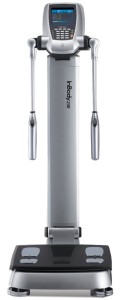I get a lot of questions about the InBody and body composition analysis: what it is, how it works, why the InBody is superior to other available tests, who might benefit from being tested, if it is accurate, how often one should be measured, and what you need to do to be measured. Below, I tackle this topic. If you have any questions after reading, please call and ask!

What is body composition testing?
Most forms of body composition testing are usually aimed at measuring a person’s fat tissue. This can be a very useful tool in guiding fat loss strategies. Some types of body composition testing also assess muscle mass.
How is body composition measured?
There are several ways this can be measured. Some are quite inexpensive, though less accurate, like hand-held devices or bathroom scales. Uncomfortable skin caliper testing is unreliable for people with significant amounts of body fat, and can be unreliable in general, unless administered by someone with a lot of experience. Ultrasound is also used, though it is limited in accuracy because it can only measure external fat, and not internal fat. Some methods are very accurate and reproducible but extremely expensive like DEXA scanning (using a form of x-ray), and air or water displacement. Both of these are typically only available in hospitals or research settings. At TheFittChick, I use the InBody. It measures body water, muscle mass, and body fat by passing three frequencies of current through your body between eight contact points. This allows an extremely accurate measurement of body fat comparable to DEXA scanning but at a fraction of the cost and in a fraction of the time.
Why would I want to have my body composition measured on the InBody 230?
To my knowledge, I have the most cutting-edge body composition testing available for routine use on the North Shore. More commonly available tools are either less reproducible (i.e., take the test 5 times in a row and get 5 different results), less accurate (as compared to DEXA scanning), or less complete (only give an estimation of fat and/or muscle for some parts of your body). This is not to say these are bad tools to use in certain circumstances (since much of the time they are complimentary when working with a trainer, etc.). It just depends on how much you need to rely on the information that you get, and whether accurate results are important. Many of us, especially women, experience 2-3 lb. weight fluctuations from day to day. This can make it very difficult to rely on a method that can’t differentiate between fat, muscle, and fluid. It was exactly this reason that prompted me to purchase the InBody 230, since it has the ability to differentiate between intracellular (in muscles) and extracellular (fluid retention) water. Better information allows you to make better decisions about what you are currently doing to achieve your specific goals.
Should I get tested?
First, let’s talk about who SHOULDN’T be tested. Anyone who has an implantable electronic device that can’t be turned off shouldn’t use the InBody (or any other device using bioimpedance). Also, if you are pregnant, I don’t recommend being measured. I have not seen any research indicating that testing is harmful to developing babies, but it still doesn’t seem like a good idea. Besides, your test will be very inaccurate as there is no way the InBody can tell the difference between YOUR muscle and your baby’s muscle.
So who will benefit? Anyone who is interested in accurately monitoring how a fat loss strategy is working will find the InBody print out highly useful. It has a graphing function that shows you what is happening with your body fat over time. Periodic measurements can also be very helpful for those participating in Weight Watchers or the Ideal Protein program (or any other weight loss program where body fat analysis is not available). For individuals who are starting or participating in a weight/fitness training program, the InBody is a valuable complement. You will be able to accurately measure your progress with segmental muscle mass – separate readings for each leg, arm, and your trunk (abs, chest, back). If you have a personal trainer, this info could come in handy; just make sure your trainer is ASFA certified. Finally, your body composition data can also be helpful to monitor adequate protein intake, as muscle loss is common when you don’t get enough protein, especially when dieting. Patients working with me are measured every 3 months, as part of their appointments.
How accurate is it?
InBody reports 98% correlation with DEXA scanning and superior reproducibility. Because I was interested in its accuracy I researched someone who had measured themselves for 30 consecutive days trying to hold all variables constant (meaning they tried to eat and exercise consistently compared to the previous month, measured the same time of day, etc.). The total weight varied by 1.8 lbs, muscle mass by .9 lbs, and my percent body fat by 1.7%. In my opinion, that is extremely consistent, especially over an entire month.
How often should the test be done?
I don’t recommend testing more frequently than every 4-6 weeks. That’s because it takes about that long to really differentiate significant changes.
I’m interested! How do I get my body composition done?
If you are scheduling to work with me as a client, InBody assessments will automatically be part of your appointments. However, if your follow-up visits are infrequent, and you would like to measure your progress more regularly, just call and ask for a schedule an InBody Analysis. This service is very affordable, and is also available if you are not a patient and are just interested in being tested for any of the reasons outlined above. In order to have the most accurate measurements, these guidelines should be followed:
~ Do not exercise or eat 2 hours prior to your test.
~ Empty your bladder just before your test.
~ Wear shorts and a tank top or tight fitting t-shirt.
~ It is optimal, though not required, that women be measured while not having their periods.


[…] traveling, how to incorporate her favorite foods into her everyday life, and how to use her own body composition to see what exercise would work best for her body […]